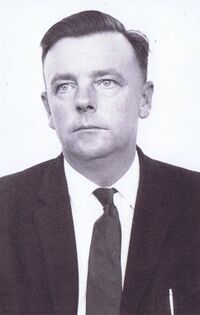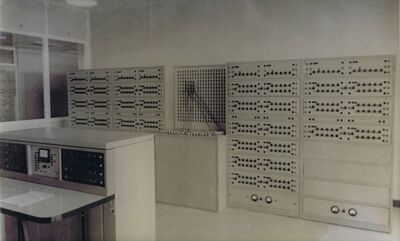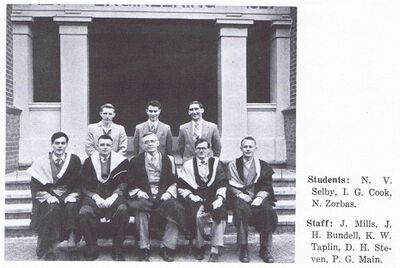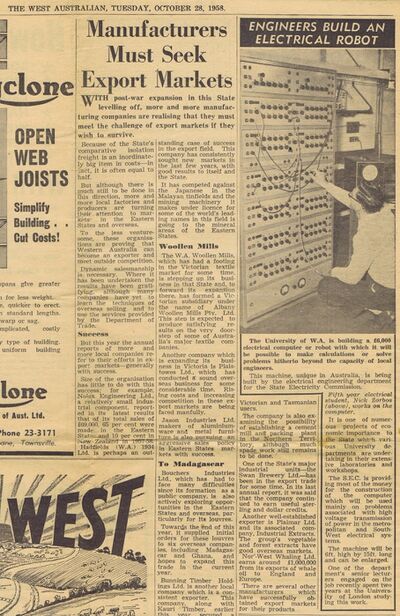Howard Bundell
BUNDELL, John Howard Lefevre (Howard), BSc, BE, MSc, DIC, PhD, MIEE, MIEAust (1927 – 2002)
Howard was born on 15 January 1927 in Guildford, to William George Bundell and Emily Louisa Bundell nee Pickering. He was awarded a State Scholarship to Modern School in November 1939 and attended from 1940 to 1942. He began Engineering at UWA in 1943, completing the requirements of the wartime BSc in Engineering in 1945 and the BE in 1946.
In 1947, he was briefly employed by the Commonwealth Department of Works and Housing, but spent most of 1947 as a Lecturer in Electrical Engineering at the South Australian School of Mines and Industry.
He returned to Perth in early 1948 and accepted a lectureship from Keith Taplin at UWA’s Department of Electrical Engineering. He remained at UWA until retirement as a Senior Lecturer in January 1988, just under 40 years later. He was acting Head of Department for varying periods of up to a year, and Sub-Dean of the Faculty for two years.
He joined the Institution of Engineers Australia in 1948 as a Student Member and became a full Member in 1957.
He was awarded a MSc in Engineering at Imperial College, London in 1957 and a PhD at UWA in 1963. His main research area in later years was alternative energy, particularly wind energy.
Notably in 1958, Howard, with another Lecturer (Duncan Steven) at the Electrical Engineering Department, designed and constructed what the West Australian newspaper in an article referred to as an “Electrical Robot”. The article noted that the machine cost £6,000 to build, was mostly funded by the State Energy Commission, and that it would “solve problems hitherto beyond the capacity of local engineers”. Featuring with a photograph of part of the machine with final year student (Nick Zorbas) the article also noted that it would be used mainly on problems associated with the high-voltage transmission of power in the Metropolitan and South-West electrical systems.
More technically, this machine was an early transformer analogue computer which they called the “TAC”. It used high precision instrumentation transformers for multiplication and division which (in contrast to the early digital computers that were only just-starting to appear at the time) could be done at near light speed. It also provided a very natural environment for simulating faults and transients in electrical power systems and was initially used to model the performance of the 132kV South Fremantle and East Perth to Bunbury transmission line as documented in Howard’s PhD thesis. Given the time period of rapidly changing technology in which it was developed, the machine used a creative mix of 12AT7 twin-triode valves for power amplifiers, patch panels for “programming”, telephone uniselectors for switching transformer winding connections and OC71 transistors for signal amplifiers and phase detectors.
Howard lectured mostly in rotating electrical machines and power systems in the later years of the Electrical Engineering programme. The Non Loqui University Engineers Club publication of 1958 has the following description of his teaching: “Another keen Goonist, with amazing powers of concentration (never once put chalk in mouth and tried to write with cigarette) – very approachable and always knows the clever thing to do – writes extremely well but too fast for anyone to copy down notes (aware of this, he has taken to reading lectures out of textbooks) – conveniently gets through about twice as much this way, also – holder of record for longest lecture delivered (2 hours, 15 minutes). (A mighty achievement in the face of eleven open mouths and twenty two closed eyes)."
Other notable projects he was involved in at UWA were:
• In the 1970’s, with Brian Leary, another Lecturer in Electrical Engineering at UWA, converted a Mini motor car to a purely battery electric vehicle for the study of electrical motor and power electronics integration.
• In the mid-1980’s, he established a State Electricity Commission funded wind turbines research programme at UWA – installing and instrumenting an imported 60kW Westwind wind turbine at Ballajura to study induction motor control optimisation and grid electrical integration issues.
Like many other UWA engineering staff of the time, such as John Appleyard and Gordon Lutz, Howard was also a keen golfer at Chidley Point Golf Club. Howard died on July 26, 2002 aged 75, survived by two sons from his first wife (Norma Jewell Rosenberg, eldest daughter of Jules Rosenberg a notable Perth Electrical Engineer in his time), and three granddaughters. Inspired by his example, his eldest son joined the same Department as a Senior Lecturer just after Howard retired in 1990. His son left UWA in 2010 after serving as Head of School of Electrical, Electronic and Computer Engineering from 2003-2007.
In 2002, the School celebrated its 100th PhD graduation at a UWA hosted dinner at which Howard (then just deceased) and fellow first PhD graduate (John Mills) both from 1963, were given a framed recognition certificate.
Biography prepared by Gary Bundell, June 2024, supplemented by Fatima Kazemi and Chris Fitzhardinge, October 2025.
References:
Perth Modern School Reunion, 1938-1942, 50th Anniversary Booklet, 1992
The West Australian Newspaper, Oct 28, 1958, “Engineers build an Electrical Robot”, page 42
UWA PhD Thesis, “Analogue Computation with Near-Ideal Transformers”, JH Bundell, 1962
C.V. Nayar & J.H. Bundell. “Output Power Controller for a Wind-Driven Induction Generator” in IEEE Trans. Aerospace and Electronic Systems, Vol AES-23. No 3, May 1987, pp 388-401
University Engineers Club Publication, Non Loqui, Page 56-57. 1958
Attachment:



